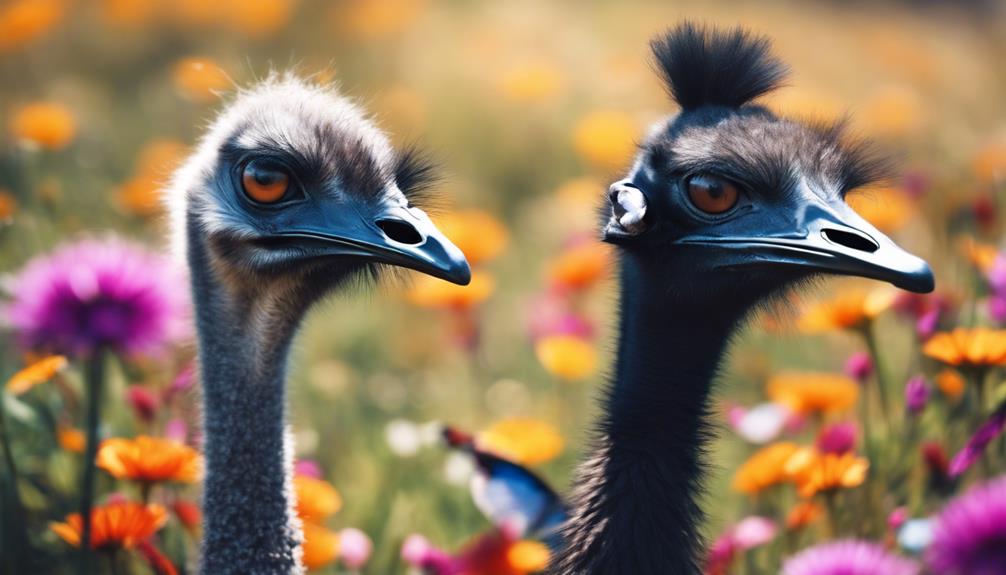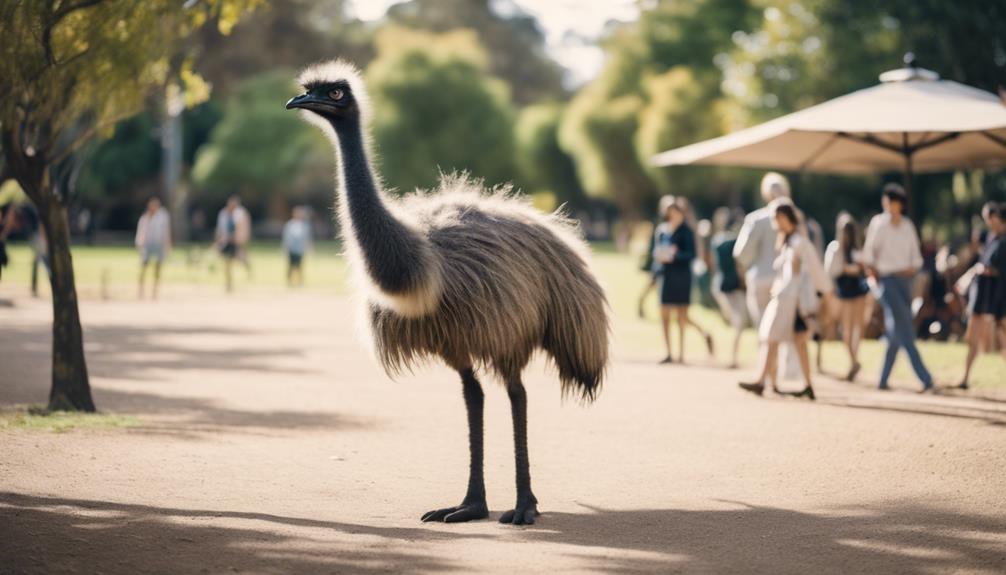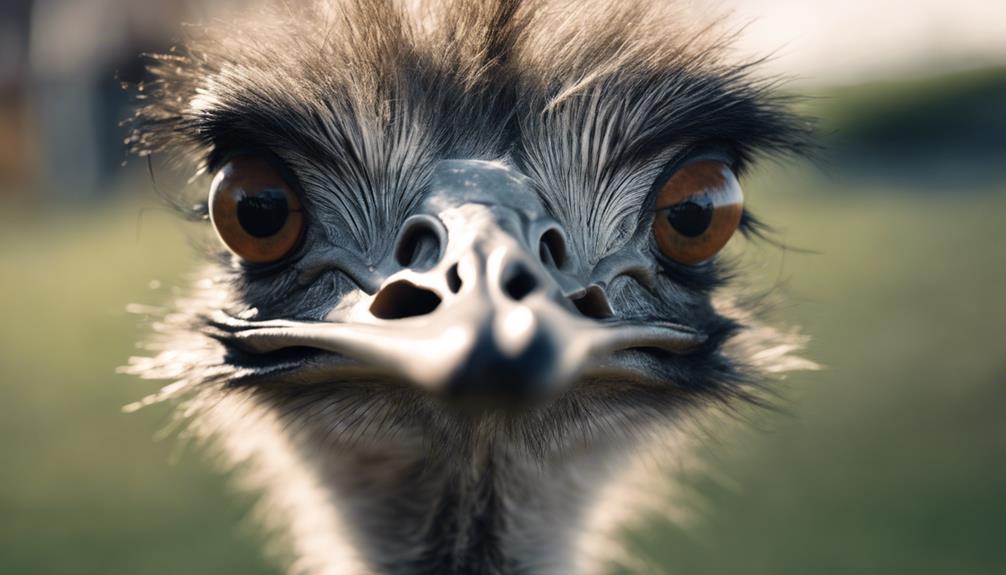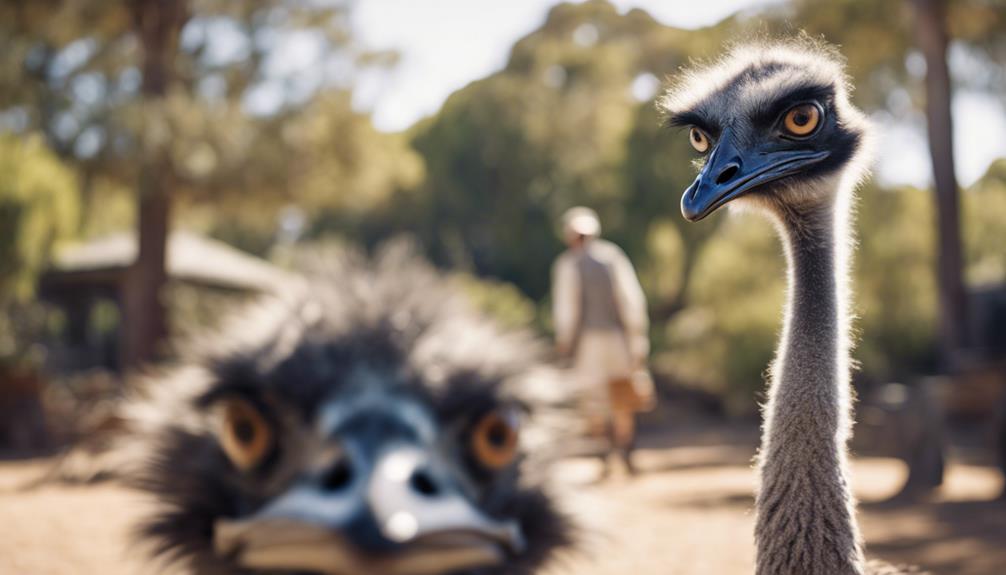
When you think of emus, do you see them as mysterious giants of the Australian outback?
Let's address the tales and truths surrounding these fascinating flightless birds.
Prepare to challenge what you thought you knew about emus, as we uncover the reality behind their behaviors and capabilities.
Key Takeaways
- Emus are intelligent birds capable of problem-solving and exhibiting complex behaviors.
- Emus' wings are adapted for running, not flying, making them swift and agile on various terrains.
- Emus have a diverse omnivorous diet, including plants, insects, and small vertebrates, aiding their adaptability.
- Emus, although not aggressive, display defensive behaviors when threatened, emphasizing the need for respectful interactions.
Emus Are Dangerous Predators

Emus aren't inherently dangerous predators, as they primarily feed on plants and insects in their natural habitat. Despite their intimidating size and powerful legs, emus are known more for their defensive behavior rather than predatory instincts. In fact, in Australian culture, emus have been utilized as livestock guardians due to their alertness and territorial nature.
Emus as livestock guardians have proven to be effective in protecting herds from potential threats, showcasing their ability to be beneficial companions in agricultural settings. Their keen sense of awareness and loud, booming calls serve as deterrents to intruders, making them valuable assets in safeguarding livestock.
Within Australian culture, emus hold a significant place, symbolizing resilience and adaptability in the harsh Outback environment. Their presence in indigenous stories and artworks reflects their cultural importance and the deep connection between the native people and these unique birds. Far from being dangerous, emus play a vital role in ecosystems and human societies alike.
Emus Cannot Walk Backwards
Despite their unique physiology and remarkable adaptability, emus exhibit a fascinating trait that sets them apart from many other birds. Emus can't walk backward due to their anatomy and behavior. This inability is attributed to their long legs, specifically their knee joints, which are designed to support forward motion with great efficiency. Emus have adapted to thrive in their environments by evolving this forward-focused anatomy.
Emus' behavior also plays a role in their inability to walk backward. These birds are known for their forward-thinking nature, constantly moving ahead to seek out food, water, and safety. This forward momentum aligns with their natural instincts and survival strategies.
Furthermore, the structure of their feet and toes, which are optimized for swift forward movement, further restricts their ability to walk in reverse. Emus' anatomy and behavior have coevolved to enhance their efficiency and agility in forward motion, making them unique among avian species.
Emus Are Aggressive Towards Humans

When encountering humans, emus typically display defensive behaviors rather than outright aggression. Emus are naturally curious animals, and their social behavior is more geared towards establishing a hierarchy within their groups rather than attacking humans. However, if they feel threatened or cornered, emus may exhibit defensive actions such as hissing, spreading their wings, or kicking. Understanding their body language can help prevent misunderstandings between humans and emus.
| Emus' Social Behavior | Emus' Diet Preferences |
|---|---|
| Emus are social birds that typically live in pairs or small groups. They communicate through various vocalizations and body movements. | Emus are omnivores, but their diet mainly consists of plants like fruits, seeds, and leaves. They also consume insects, small vertebrates, and even small rocks to aid in digestion. |
It's important to respect emus' space and observe them from a safe distance to avoid triggering any defensive reactions. By understanding their social behavior and diet preferences, interactions between humans and emus can be more harmonious.
Emus Can Outrun Cars
While on the road, drivers should be aware that emus possess remarkable speed capabilities that may enable them to outrun cars in certain circumstances. Emus, known for their agility and swiftness, can reach speeds of up to 30 miles per hour, making them one of the fastest land birds. Despite their large size and seemingly awkward appearance, emus are surprisingly quick on their feet.
- Emus vs. cheetahs, speed comparison: While emus are nowhere near as fast as cheetahs, which can sprint at speeds exceeding 60 miles per hour, their running abilities are still impressive in the avian world.
- Emus in races, entertainment value: Emus have been featured in races and competitions, showcasing their speed and providing entertainment for spectators. These events highlight the unique athleticism of these flightless birds.
- Evolved for speed: Emus have evolved over time to develop powerful leg muscles that propel them forward with remarkable speed and efficiency.
- Adaptable runners: Emus can navigate various terrains with ease, utilizing their speed not just for escape but also for hunting and foraging.
Emus Have Useless Wings

Emus, despite their wings being present, primarily serve a limited purpose and are considered largely useless in terms of flight. The wing functionality of emus is intriguing; their wings have evolved to be short, stumpy, and lack the necessary adaptations for sustained flight. Instead, these wings are more akin to rudimentary structures with minimal muscle mass, rendering them incapable of lifting the emu's large body off the ground.
In terms of flight capabilities, emus rely on their powerful legs for speed and agility rather than their wings. The wing anatomy of emus reflects their adaptation to a terrestrial lifestyle, emphasizing running prowess over flying abilities. This evolutionary shift highlights the prioritization of ground mobility in emus, leading to the reduction of wing size and functionality over time.
While emus may use their wings for balance and display during courtship rituals, their primary purpose remains a vestigial reminder of a distant flying ancestry.
Emus Are Dumb Birds
Often misunderstood, the intelligence of emus is a subject that warrants a closer examination. Emus aren't as dumb as commonly believed. In fact, they exhibit remarkable cognitive abilities and problem-solving skills that showcase their intelligence. Here are some insights into emu intelligence and behavior:
- Bird Intelligence: Emus belong to a group of birds known for their cleverness. They can learn and adapt to different situations, showing a level of intelligence that goes beyond mere instinct.
- Emu Cognition: Studies have revealed that emus possess a high level of cognitive function. They can remember and recall information, which is essential for their survival in the wild.
- Problem-Solving Skills: Emus have been observed using their intelligence to solve various problems, such as finding food and navigating their environment.
- Behavioral Adaptations: Emus display complex behaviors that indicate their intelligence, such as cooperative breeding strategies and effective communication within their social groups.
Emus Only Eat Plants

Despite their intelligence and problem-solving skills, emus aren't limited to consuming only plants in their diet. These omnivorous emus exhibit unique diet habits that may surprise many. While emus primarily feed on plants like fruits, seeds, and leaves, they're opportunistic eaters and will also consume insects, small mammals, reptiles, and even the occasional bird.
Emus have been observed pecking at insects like grasshoppers, crickets, and beetles, supplementing their plant-based diet with a good source of protein. They've also been known to eat small vertebrates such as lizards and rodents when the opportunity arises. This diverse diet allows emus to adapt to various environmental conditions and ensures they receive essential nutrients vital for their growth and survival.
Emus Are Solitary Creatures
Do emus typically prefer solitary or social interactions in their natural habitat? Emus are often perceived as solitary creatures, but in reality, they exhibit a combination of social behavior and independence. Understanding their natural tendencies can provide insight into their reproductive habits and overall lifestyle.
- Social Behavior: Emus are known to form small groups, especially during mating season. These groups typically consist of a breeding pair and sometimes a few non-breeding adults.
- Reproductive Habits: During the breeding season, male emus will initiate courtship displays to attract females. Once a female chooses a mate, they'll stay together for the duration of the breeding season.
- Family Dynamics: After the female lays her eggs, the male takes on the responsibility of incubating them while the female may mate with other males or move on to lay more eggs.
- Group Interactions: While emus may form social groups, they also value their independence and may wander off alone for feeding or resting purposes.
Emus exhibit a balance between social interactions and solitary behavior, showcasing a fascinating mix of communal living and individual freedom in their natural habitat.
Emus Have Poor Eyesight

Emus, despite their impressive adaptability, possess relatively poor eyesight compared to their other sensory abilities. This aspect of their biology is crucial to understand when observing emu behavior in their natural habitat. Emus have evolved to rely more on their hearing and sense of touch to navigate their surroundings effectively.
In the vast expanses of the Australian outback where emus roam, their poor eyesight is balanced by their keen awareness of sound and vibration. Their habitat, characterized by open plains and scrubland, requires them to be alert to potential threats and opportunities for foraging. Emus often tilt their heads to use their acute hearing to detect sounds from afar, enhancing their ability to detect predators or locate sources of food.
While their visual acuity may be limited, emus have adapted well to their environment through a combination of behaviors that compensate for their poor eyesight. Understanding this aspect of emu biology sheds light on how these fascinating creatures thrive in their challenging habitat.
Emus Make Good Pets
Considered as exotic pets by some, emus can pose unique challenges due to their specific needs and behaviors. While emus can be fascinating companions, it's crucial to understand the essential care requirements before considering them as pets.
Emus as Companions:
- Emus can form strong bonds with their human caregivers, displaying affection and loyalty.
- They've distinct personalities and can be social animals, enjoying interaction with their owners.
- Emus are intelligent creatures that can recognize individuals and respond to familiar faces.
- Despite their large size, emus can be gentle and curious, making them intriguing companions for those willing to meet their needs.
Emu Care Essentials:
- Providing ample space for emus to roam and exercise is vital for their physical and mental well-being.
- Emus require a diet rich in fruits, vegetables, and high-quality emu feed to maintain their health.
- Regular veterinary check-ups and parasite prevention measures are essential to ensure the well-being of pet emus.
- Emus need access to clean water for drinking and bathing to support their hygiene and overall health.
Emus Are Endangered Species

Emus face a critical threat to their existence as their population numbers dwindle in the wild due to various environmental challenges. The conservation status of emus is a significant concern, with habitat loss being a primary factor contributing to their decline. Emu habitat preservation is crucial to ensuring the long-term survival of this iconic species. Efforts to protect and restore their natural habitats are essential components of Emu conservation efforts.
In response to the declining emu populations, conservation organizations are actively involved in initiatives aimed at safeguarding these birds. Emu conservation efforts focus on implementing strategies to mitigate the impact of habitat destruction, such as establishing protected areas and promoting sustainable land management practices. Additionally, raising awareness about the importance of preserving emu habitats is vital in garnering support for conservation endeavors.
Emus Are Related to Ostriches
Belonging to the same family as ostriches, emus share a close evolutionary relationship with these large flightless birds. Emus and ostriches exhibit several similarities in their habitats and behavior, shedding light on their shared ancestry:
- Habitats: Both emus and ostriches are native to open grasslands, savannas, and woodlands, preferring areas where they can easily spot predators and flee if necessary.
- Diet: These birds are omnivores, feeding on a diet consisting mainly of plants, insects, small vertebrates, and fruits, showcasing their adaptable feeding habits.
- Reproduction: Emus and ostriches construct shallow nests on the ground where females lay large eggs, with males taking the primary role in incubating the eggs and caring for the chicks.
- Social Structure: While emus and ostriches are generally solitary foragers, they may form small groups or pairs during mating season, emphasizing their flexible social behaviors influenced by environmental factors.
Understanding the striking similarities between emus and ostriches provides valuable insights into the evolutionary history and ecological adaptations of these fascinating birds.
Frequently Asked Questions
Can Emus Fly?
Emus are flightless birds due to their anatomy. Their bodies are adapted for running, not flying. Their wings are small and not developed for flight. Emus rely on their strong legs for movement instead.
Do Emus Have Any Natural Predators?
In the wild, emus face threats from predators like dingoes, eagles, and hawks. Predation patterns play a role in shaping their survival strategies. Conservation efforts are crucial to maintain the balance of their ecosystem roles.
How Long Do Emus Typically Live in the Wild?
In the wild, emus typically live between 10 to 20 years. Their average lifespan varies due to factors like habitat range, availability of food, and threats from predators. Emus thrive in diverse environments.
Are Emus Social Animals or Do They Prefer to Be Alone?
Emus are social animals, exhibiting strong group dynamics and communication skills. While they may prefer to be in groups, they can also display solitary habits. This balance allows them to thrive in various environments.
Are There Any Cultural or Mythological Significance Associated With Emus in Different Societies?
Emus hold cultural significance in various societies. They appear in folklore, art, rituals, and symbols. These connections reflect the diverse ways different cultures have integrated emus into their traditions, beliefs, and expressions.
Conclusion
In conclusion, Emus are fascinating creatures that often fall victim to common misconceptions. They aren't dangerous predators, can't walk backwards, and don't pose a significant threat to humans. While they may appear aggressive, they're simply defending themselves.
Emus aren't endangered species and aren't related to ostriches. Next time you encounter an emu, remember these facts and appreciate their unique characteristics in the vast Australian landscape.


